|
| At the 'Drolma La' Pass - the Prayer Flags. | |
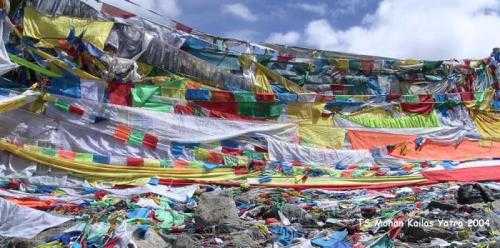
|
|
The summit point of the Drolma La pass. The huge mass of Prayer flags speak of the number of Pilgrims
who have successfully made it to this holy place. I could not take any photos from Dheer Puk to this
place - too busy climbing up slowly and too distracted by the breathlessness!
|
| From the Drolma La away Mt. Kailash - The rugged Mountains | |
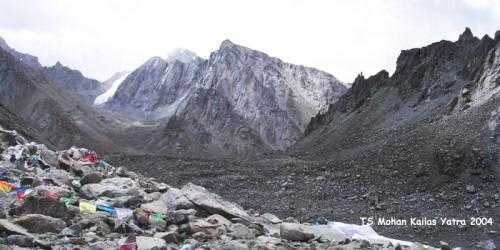
|
|
The ruggedness of the mountainous terrain hits you hard!
|
| After the Prayers at Drolma La | |
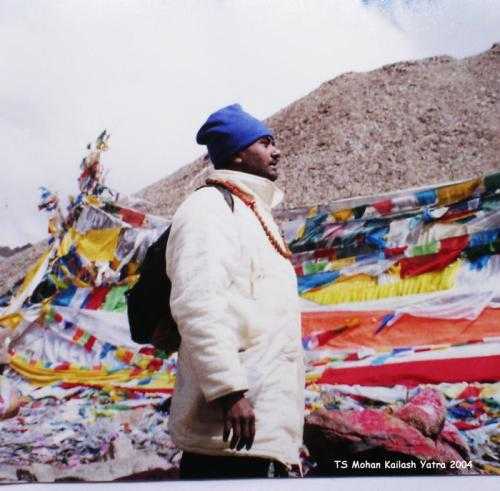
|
|
Notice the 'kum-kum' or vermillion covered stone! There is no formal temple or structure here except for the
mass of Prayer flags. Hence every stone is sacred. And this stone is the most. Prayers are offered, prayer
flags tied, incense burnt and 'ahir' (rice grains colored with 'kum-kum') sprinkled. After tying up
the prayer flag I had brought along, I soaked in the ambience.
|
| With Swami Ishwaranandaji, Chinmaya Misison, Mumbai | |
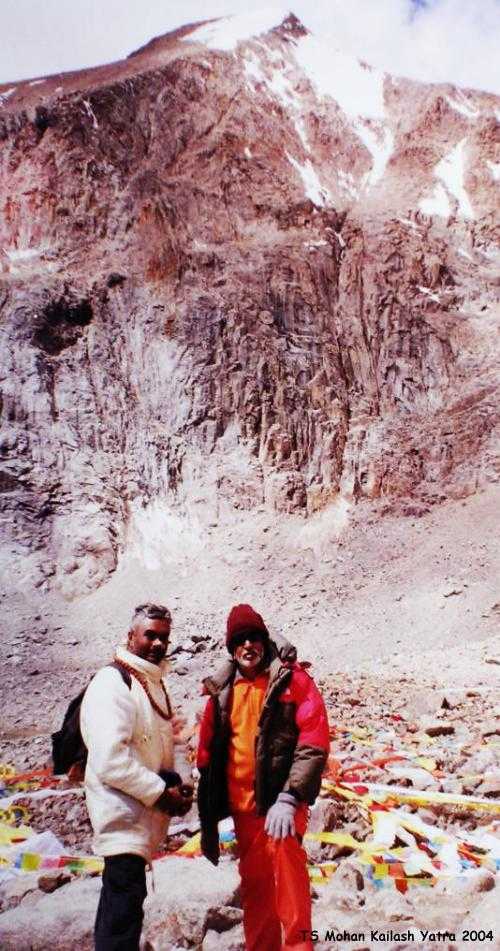
|
|
It was nice to rendezvous here with the revered Swamiji. And offered to be photographed with him.
Do spiritual austerities produce a ruggedness of character in living life like the mountain behind?
|
| The Holy Gouri Kund Lake near Drolma La | |
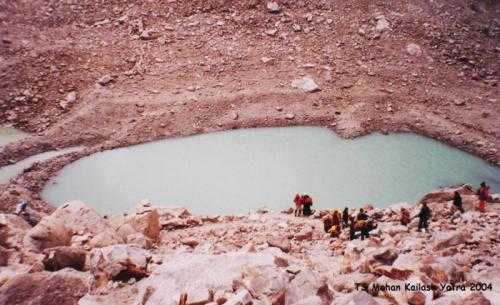
|
|
This lake (or set of lakes depending on when one visits) is the highest fresh water lake in the vicinity of
Mt. Kailash. Lord Ganesha was born to Parvati Devi here. Yes, everyone goes in to fill in their containers
with the holy water.
|
| Descending down from Drolma La | |
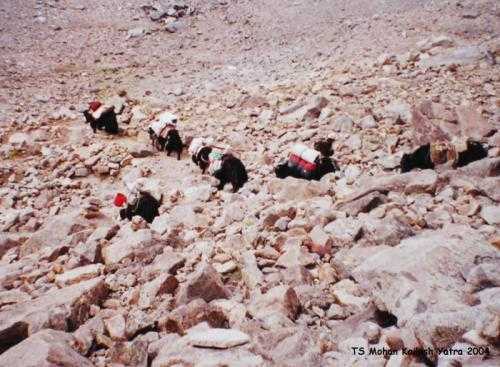
|
|
Passengers off-loaded, the yaks descend down the boulders! None can dream of still balancing,
sitting on it let alone
ride it.
|
| Descending down to cross the Glacier | |
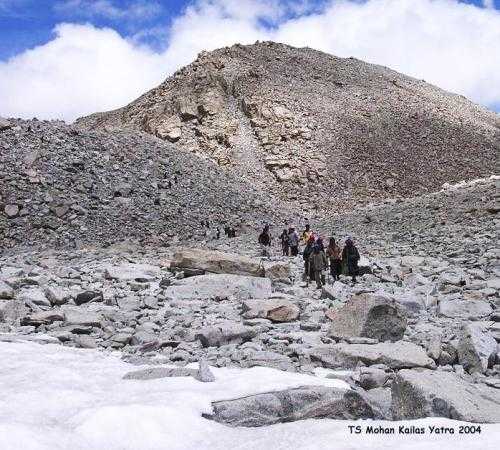
|
|
Coming down from the Gauri Kund, one comes across a receding glacier (depending on when one
does the parikrama). Yes, boulders mark the approach path to the glacier. And its action is very
visible on these huge stones.Underneath them one can see a rivulet flowing.
|
| On the Glacier | |
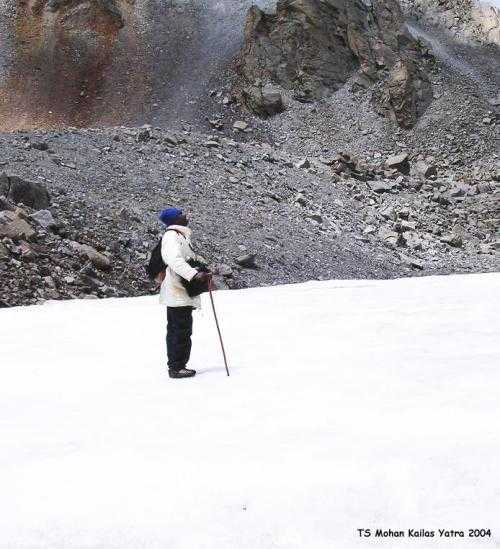
|
|
Soaking in the ambience around! The mind says - meditate, meditate, meditate! The mountain hiking pole
can have a good substitute in a walking stick too.
|
| Ruggedness Galore | |
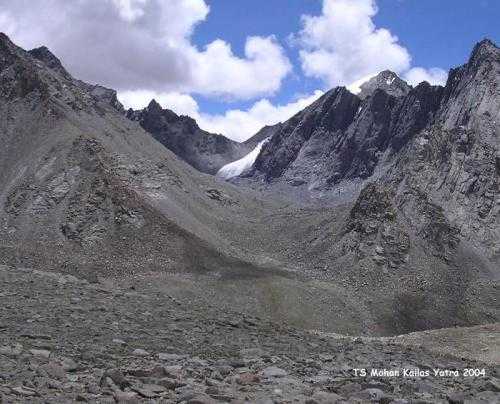
|
|
Inspirational? Challenging? Awesome? Fierce? Whats in it for us in living our daily lives?
|
| Amongst the craggy mountains | |
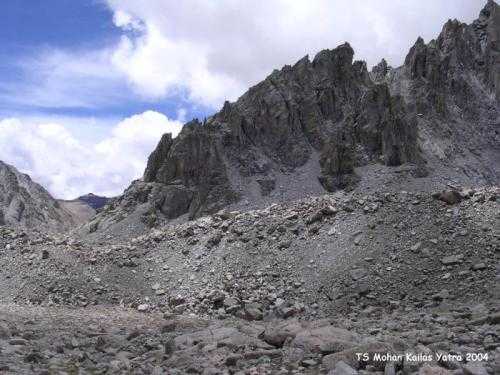
|
|
Spiritual Life can be like the persevering journey amongst these mountains - the rough and tumble of existence
versus the calm solidary peaceful way of passing through them!
|
| Old Tibetan Pilgrims doing the 'Kora' | |
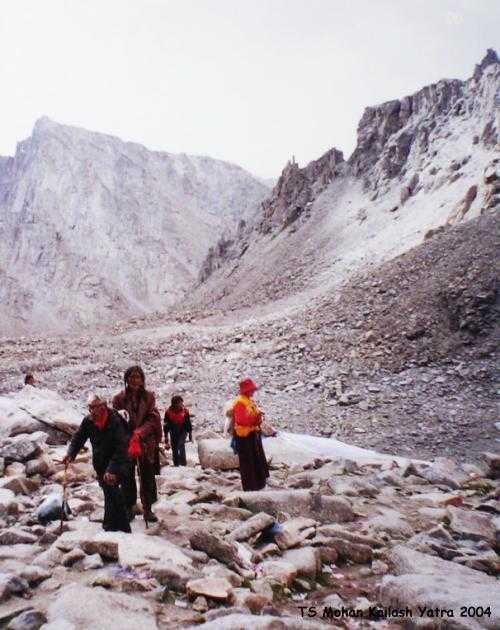
|
|
Human capabilities are profound - here was a old Tibetan man of 70+ years walking with two walking sticks.
The younger ones were there to help him in his endeavours. Inspiring? Yes!
|
| Young Tibetan Pilgrims doing the 'Kora' | |
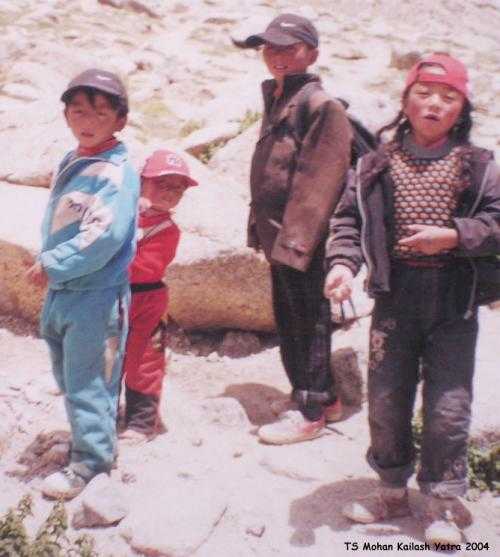
|
|
And the little ones did not lag behind - here was a four year 'parikrama' yatri doing the full 'kora' on foot.
'Mom, Dad - dont know where they are right now! May be far behind.' I saw a Tibetan woman with a 4 month old
baby doing the 'kora' at these heights! Amazing!
|
| After coming down to the valley of the river 'Lham Chu' | |
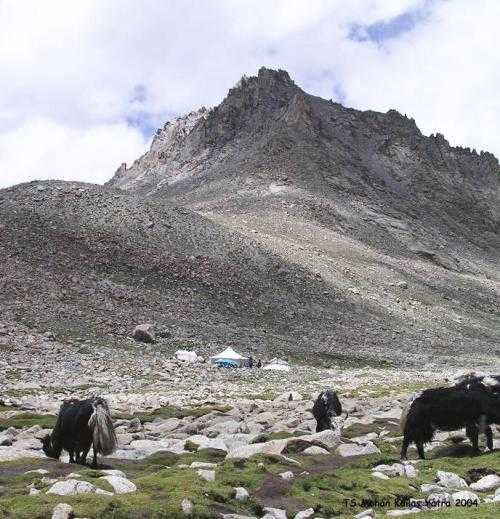
|
|
The Yaks have done their job in reaching the 'Lham Chu' valley - this is their 'fuel stop' enroute Zutul Puk that is another
four or five hours away.
|
|
|
The Yatra Diary
Day 8: Monday 2nd August 2004
From Dheerpuk to Drolma La to Zutul Puk
Early morning next day, we had our breakfast and soup with lots of garlic. This was the most challenging
day of the parikrama - we had to climb up more than 800m and cross the 'Drolma La' - the Drolma
pass (5600+ m). People packed up and everyone started off - no group activity here. Each to himself.
For several steps of the climb, am left breathless - needless to say, I had to stop to calm down my
palpitating heart. "Om Namah Shivayah!". Several more steps and one more stop - this repeated.
The climb, not very steep, is through pathways
amongst huge boulders and rocks. After few hours of this strenous tapas I reached the Drolma La. On
the way, several yaks and horses with their passenger-riders crossed me. Some of them present a
pathetic sight.
Desparately clinging to the animal - not having had any training whatsover
in riding any animal, many elderly people especially ladies make a heroic effort to stay balanced on
these wayward animals - the horses could be jittery and throw the passengers off - the yak rides
get to be even more crazy - they do not follow any set path (and are controlled by whistles from the
yak-man, stray frequently to eat grass, brush
against each other and against the boulders ("ouch! my leg...", you can hear the cries to the Tibetan
yak man who does not understand - he laughs it off). They will get into the streams in
wrong places with these devotees precariously perched .... well thank God, I have the stamina to
walk! At the end of the day, the devotee-riders feel relieved! In the flat lands, the ride is smooth.
At the Drolma-La, there is a huge offering of prayer flags tied everywhere. I had bought one in
Kathmandu. After offering my prayer to Devi Tara or Goddess Drolma, I tied the flags strung
on a long chord (about 20feet in length). Some offered incense and 'ahir' (rice grains). That done, I gathered my
belongings and spent sometime with the other devotees of Lord Shiva. Amongst them was Revered Swami
Ishwaranandaji from the Chinmaya Mission, Sandeepany Sadhanalaya, Mumbai - we had a
group photos taken with him.
Looking around, one is struck by the sheer gross ruggedness of the terrain. The tough and the solid long
with the literally crumbling mountain range. Huge blouders along. Wonderful sight. The Mind said - Meditate,
Meditate, Meditate!
A few meters down the path through the boulders we got to see the wonderful Lake Gouri Kund
below in the cusp amongst the surrounding rocky peaks. The water is greenish blue - the color
of the sky. Few who were adventurous ventured down to fill in bottles and plastic cans with the holy waters.
Others proceeded along the path that led beyond and down. The trek was less strenous as it was a down
gradient.
All the yak and horse riders are off-loaded at this pass. They need to trek down
the down-gradient until they reach the river valley (the Lham Chu river). So, the yatris should be fit for
this trek - many elderly yatris complain since they are not aware and prepared for this part of the parikrama (they are not used
to walking a few kilometers - they just walk short distances). Along the river valley, the trek is somewhat on flat ground
and is several kilometers long.
We crossed a mini - glacier with snow that had hardened into ice.
And walk along and amidst the huge boulders that the water and ice had cut. And then over several
humpy big descents, we spot the first signs of human habitation. A wandering tent-tea-house
for all people who had managed to successfully descend without hurting themselves. And beyond
was a river flowing down a long valley with several peaks on both sides. There was good relief that we were
coming down to flat gradients.
Yaks and horses were grazing around. Awaiting their passenger loads.
After resting for a while, we started for Zutul Puk, the campsite for the night. A good several hours
trek away. Very thirsty and with no water, I drank the water from river stream taking on the attendant risk of stomach infections.
Though the waters were pure, they were 'polluted' by the animals and the bacterial / moss
growth along the way. The waters were cold!
After a long trek, at last we reached our campsite along the river waters. A beautiful location but we
were too tired. After dinner, we just went asleep.
|
High Altitude Sickness - HAS - (Or Acute Mountain Sickness - AMS)
 There are several interesting articles in several mountaineering websites on High Altitude Sickness.
Here is a brief on it:
Oxygen available for breathing varies with atmospheric pressure and as we climb to altitudes higher
than 3000 meters, a number of symptoms start showing up - all caused by the lack of oxygen in the brain
and possible dehydration.
There are several interesting articles in several mountaineering websites on High Altitude Sickness.
Here is a brief on it:
Oxygen available for breathing varies with atmospheric pressure and as we climb to altitudes higher
than 3000 meters, a number of symptoms start showing up - all caused by the lack of oxygen in the brain
and possible dehydration.
It happens to people irrelevant of age (meaning younger people also get afflicted) and
the severity of the symptoms vary - for some it might be mild and disappears with acclimatization, for
others it might persist and yet for a few unfortunate ones, it might turn acute.
There are a number of factors that add to this sickness. If the
sickness turns acute and is not promptly attended to, then it can fatal. For trekkers of altitudes beyond
6000 m, there is a mortality rate of 4%.
 When a yatri flies in or drives to places above 3000 m altitude, over a period of first several hours,
he or she might start having unusual headache, breathlessness on exertion, palpitation of heart,
loss of appetite, nausea, vomiting, giddiness, irregular breath and irregular or difficulty in sleeping.
These are accentuated by rapid ascent, undue exertion (like exercising) or carrying loads as well.
When a yatri flies in or drives to places above 3000 m altitude, over a period of first several hours,
he or she might start having unusual headache, breathlessness on exertion, palpitation of heart,
loss of appetite, nausea, vomiting, giddiness, irregular breath and irregular or difficulty in sleeping.
These are accentuated by rapid ascent, undue exertion (like exercising) or carrying loads as well.
Invariably, every yatri should acclimatize for atleast 24 hours at Nyalam-mu (4200 m) before proceeding
on the journey. Why is this important? The only meaningful cure for acute situation is a rapid descent
in altitude - which means getting back to Zhang-mu or perhaps to Kodari. It is possible only at Nyalam-mu.
In other places (like Saga or
Paryang or along the way where the drive is across a pass) this may not be possible. Yatris
with high blood pressure, heart and lung disorders (asthma etc) are more at risk.
And are strongly recommended
against undertaking this yatra.
Remember, at Dheerpuk (4800 m) or Zutul Puk (4700 m) the oxygen concentration in the air
is about half of that at sea-level. At Drolma-La pass, it is still lesser.
More details are available in the pages of the
Irish Mountaineering Website
 The best way to prevent and minimize the occurence of High Altitude Sickness is by going for a graded
ascent (acclimatizing for about 24 hours
at each altitude level of about 300+ meters) and taking a
precautionay dosage of Diamox tablet (125 mg twice a day)
from Kathmandu itself (three days before reaching Nyalam-mu). When you have mild symptoms do not
travel alone. Brief your co-travellers about all medical situations and possibilities as well as what action
should be taken.
The best way to prevent and minimize the occurence of High Altitude Sickness is by going for a graded
ascent (acclimatizing for about 24 hours
at each altitude level of about 300+ meters) and taking a
precautionay dosage of Diamox tablet (125 mg twice a day)
from Kathmandu itself (three days before reaching Nyalam-mu). When you have mild symptoms do not
travel alone. Brief your co-travellers about all medical situations and possibilities as well as what action
should be taken.
If the high altitude sickness persists for more that 24 hours or becomes acute,
then take diamox 250 mg four times a day (with atleast 4 hours in between), use
oxygen from oxygen cylinders with the team and start a rapid descent to lower altitudes.
The Chinese and Nepali Sherpas are supposed to be well versed in these matters. However,
instructing / sharing with your fellow travellers on these medical matters before starting
the yatra helps a lot.
How does Diamox help? It is a diuretic - reducing the fluid retention capability of the body. This results in
more water intake, frequent urination and therefore in an indirect way more oxygen absorption into the blood.
However, there can be side-effects too: drowsiness, tingling of fingers etc. Balance and manage the
medication.
 Other sickness unique to high altitude are:
Other sickness unique to high altitude are:
* High Altitude Pulmonary Oedema (collection
of fluids in the lungs). The onset can be quick - with sputum and breathlessness. More so when
the person has infection of the chest, bad flu or bad cold. Symptoms include high pulse rate, unusual
fatigue when walking,
and breathlessness at rest. The general HAS symptoms may precede it.
Early stages of Pulmonary Oedema should be suspected if there is breathlessness at rest or due to apparent
chest infection or there is a persistent dry cough. (So if you see someone coughing persistently, caution them up! However do not cause a panic.)
* Celebral Oedema: This is due to the collection of fluids in the brain. This occurs after the High
Altitude Sickness symptoms had persisted for sometime. When celebral oedema starts, the person
or yatri becomes confused, irrational, having double visions (and possible hallucinations)
and unsteady in gait.
* Emergency counter measures for both the above cases: Administer oxygen and as quickly as possible do an altitude
descent of atleast 500 meters. Keep the patient upright rather than flat.
Other emergency measures include putting the patient into a pressure air
bag (hyperbaric chamber). A suggested emergency medication for Pulmonary Oedema
is having Nifedipine tablet (10 mg) under tongue immediately followed by
20 mg slow release every four hours; and for Celebral Oedema, it is Dexamethasone (8mg) under tongue
followed by 4mg every four hours.
|
Hallucinations and other 'Experiences':
 Some of the yatris who have medical problems might experience
hallucinations due to altitude. If really true, then it should be treated as an emergency and he/she should be
evacuated to a lower altitude immediately (It could be a case of Celebral Oedema!). However there are some
who day-dream and claim to have had visions - more so the very emotional types. One needs to be very careful here and not
go overboard in these matters.
Some of the yatris who have medical problems might experience
hallucinations due to altitude. If really true, then it should be treated as an emergency and he/she should be
evacuated to a lower altitude immediately (It could be a case of Celebral Oedema!). However there are some
who day-dream and claim to have had visions - more so the very emotional types. One needs to be very careful here and not
go overboard in these matters.
The truly spiritual types have their unique 'experiences' that are not medical
problems - just that it is varieties of quiet, peaceful heightened awareness and blissfulness that does not
impair any of the normal activities of daily life for the lifestyle chosen - essentially a kind of 'super-wellness'.
With sincere, authentic and steady sadhana, interesting spiritual experiences comes by gradually and naturally,
persists over long durations and
goes down with a disruptive and careless lifestyle. This is no voodoo! To confuse between the two has resulted in bringing
a bad name for 'adhyatmic' experiences in the contemporary times! More so given the proliferation of charlatans who look traditional
and fit into the popular image of the sadhakas.
Answering the question that most people had asked me post yatra - 'So what
experiences did you get there?' - (Incredulous questions like: Did you see 'devas'
and 'gandharvas' at Lake Manasarovar?' .) I would say NONE! And yet so many nice ones - of the super wellness kind!
 Sri Ramakrishna's life is replete with these!
Sri Ramakrishna's life is replete with these!
When Sri Ramakrishna was a young boy full of innocence and talented in mime, he was asked to substitute
for a sick young actor in a travelling mythological drama troupe in his village of Kamarpukur - to act as a meditating Shiva even as other
actors went around him, singing His glories. The scene got over, but the young 'Shiva' would not get off his pose! Initially this
triggered a lot of laughter and fun. And extempore improvisations from the 'Sutradhar'.
It took sometime for the motley
crowd of villagers to realize that the young boy was too deeply absorbed in the meditation than was participating in the drama.
It was one of the earliest stirrings of the experience called 'bhava samadhi' that Sri Ramakrishna was having daily in his later part of life.
For a more authentic and different articulation of this, one should read the book, 'Sri Ramakrishna - The Great Master' by
Swami Saradananda, available in any of the bookstalls of the Ramakrishna Math.
 Ofcourse some of these experiences might be emotionally surcharged reports by
devotees around him (perhaps exaggerated - more due to respect than anything else). Closely observing
the patterns of some of his experiences (and not taking into consideration those that are belief oriented),
one does see that his is not the psychiatric kind - but
something deeper and profound. Something that is authentic. Something
which only those fellow-travellers on the sadhana landscape can understand and co-relate with.
Something that is not induced by an artificial means like drugs or whatever. Something
that did not interfere with his daily lifestyle! But something that enriched it and made him be more complete! Ofcourse some of these experiences might be emotionally surcharged reports by
devotees around him (perhaps exaggerated - more due to respect than anything else). Closely observing
the patterns of some of his experiences (and not taking into consideration those that are belief oriented),
one does see that his is not the psychiatric kind - but
something deeper and profound. Something that is authentic. Something
which only those fellow-travellers on the sadhana landscape can understand and co-relate with.
Something that is not induced by an artificial means like drugs or whatever. Something
that did not interfere with his daily lifestyle! But something that enriched it and made him be more complete!
So, in our contemporary context, for the ordinary yatris like us, it is best to share with fellow travellers our
hallucinating inflictions and get quick medical treatment! Rather than proclaim loud and get ignominy for ourselves
and our belief systems!
|
|
|
Medical Fitness - Potential problems and Check Lists.
Here are some tips and checklists:
* Nepal does not have a good medical support system for emergencies - and for several
people - the existing setup might be strained. So watch out - carry your own medications and
travel only when the risk is minimal.
* Dental fillings might loosen up in cold weather and high altitude . So be careful in
consuming cold liquids.
* Always travel after having a thorough checkup and obtaining a medical clearance
for high altitude living (less oxygen, cold).
* Sit down with a doctor, run through this list, check how to identify the
symptoms and the degree for the right self administration of these medications
(or those specific to you)
and note when to call in external help.
* Common sickness and their medications (check the dosage with doctor):
# blocked running nose - Allercet DC (cetrizine)
# sore throat - strepsils, antiseptic gargles - Betadine
# cough - prolonged : antibiotics (Azithromycin 500, amox 500) etc
# indigestion, gas - Gelusil, digene, mosapride
# vomitting sensation - Domstal
# Motion sickness - Stemitil
# body, leg pain - Paracetamol (crocin), ibuprofen, nimusulide
# Adapting to high altitude - Diamox 250mg
# sprains - iodex, diclofenac gel
# energy loss during trek - glucose (250gms packet)
# burning eyes (snowblindness) / nose - otrivin nasal / eye drops - use sunglasses.
# giddiness (dehydration, energy loss, palpatation) - electral (4 packets), diamox
# sunburn - sunscreen lotion
# dried lips - lip balm / vaseline
# dry skin - moisturizing lotion
# constipation - isabgol
# loose motion /diarrehea / dysentry - gastrogyl, Eldopar (loperamide).
# Flu, nasal congestion - wikoryl
# General strength - Becadexamin (multi-vit) / Becosules (B-complex+)
#fever - pyrexon 650 mg
#Mouth gargle - Betadine (germicide gargle).
First Aid Kit
1. Bandaids - various sizes. Waterproof.
(atleast two dozen)
2. Antiseptic wipes / ointment
- soframycin
3. Nebasulf powder - antiseptic powder
4. knee support
5. Bandage + Cotton (6 pieces + 3 pieces)
6. adhesive tape
7. sterile dressing
8. splints
9. Thermometer
10. CRACK ointment - pain reliever
11. Diclofenac Gel - pain reliever
12. Cotton ear buds
13. Tooth picks + dental floss
I carried a entire suite of the above for the trip. I found it useful not
only for myself but for several others in the journey.
|
| General Kailash Yatra Guide - Do's and Don'ts during the trip.
Here are some tips for the Yatra:
* Don't wet the shoes at anytime! Walk carefully especially across rivers and rivulets. Use the walking stick
or the hiking pole effectively here.
Use waterproof trekking shoes meant for cold countries (it typically will be lined with thick
insulating poly foam). Should you get wet, dry it up as early as possible! Remember
a soggy shoe can spoil and injure your feet in no time. Use talcum powder to rid of the
smell.
 * Carry enough food (energy giving and not junk snacks) and water with you in the land cruiser. In
an emergency, you might have to live on it though stranded for several long hours before someone
discovers you. Carry a food box (tiffin box) with you so that whenever these sherpa cooks pack up
lunch in the morning (to be given to you for you to carry along), they will give the right food in your food container.
Also ensure that you get dry items with a gravy - we had puris, bread and chips with no gravy to go with it as lunch. * Carry enough food (energy giving and not junk snacks) and water with you in the land cruiser. In
an emergency, you might have to live on it though stranded for several long hours before someone
discovers you. Carry a food box (tiffin box) with you so that whenever these sherpa cooks pack up
lunch in the morning (to be given to you for you to carry along), they will give the right food in your food container.
Also ensure that you get dry items with a gravy - we had puris, bread and chips with no gravy to go with it as lunch.
* While shopping anywhere, with the language communication problem you can still do hard
bargaining - use the sign language. Just point to the item you seek, ask for the price - it is typically
shown on a calculator.
Start at 60% of price by keying in your number, and you might find that many times it will
click. Perhaps 40% too will.
* Bring a couple of small locks and key. These will be useful when you have to be away from your
room or your tent (yes, the tent zip can be locked).
* At many of the stops near human habitations along the way, you will get to see small children either
hanging around for some gifts or the poor literally begging. Carry freebies: ball pens, 'bhindis' and eatables.
Do not give pencils as they do not know how to use - I saw a lot of new broken pencils lying around.
Enjoy the smiles when you give!
 * If you are used to drinking water in the night, then having a one-liter flask helps a lot - especially when your
teeth is sensitive to the cold water or if you are coughing. You can mix luke warm water and consume - it helps
a lot! * If you are used to drinking water in the night, then having a one-liter flask helps a lot - especially when your
teeth is sensitive to the cold water or if you are coughing. You can mix luke warm water and consume - it helps
a lot!
* Carry a pair of sandals along - it helps during the night calls and other short walk activities even as your
shoes (and socks) are breathing up. Use talcium powder to reduce the smell.
* Ensure that you wrapup all your clothes and belongings in plastic bags within your baggage. Firstly it will help
prevent the dampness or possible drenching that baggage undergoes. In addition, it helps seggregate the used
from the unused!
* Carry your own sleeping bag if possible - especially those that can sustain you perhaps in minus 5 degrees celsius.
You need to have a inner cotton bag along with it as well. Or you can hire the combo in Kathmandu.
* When you sleep in the tent - do not cover your face - use lip balm - use gloves - never allow your feet to be
without socks ( use a separate double pair of woollen / nylon for sleeping only) - attend and nurse any shoe bites and wounds in
the feet (cold + injury can result in gangrene!).
* Within the tent never use candles or match sticks - accidental fires can destroy a lot!
* Carry an oxygen cylinder with you always if you think you will need. Several simple deodarant spray types
are available in Zhang-mu shops. They are costly though. The drivers will usually carry one for emergency (check
out if he has).
* Always report any sickness of any kind during the journey to the Sherpa and Chinese guides - they might
suggest medications and the course of action. You need to assess the seriousness too!
 * Buy the rudrakshas, spatikas and other offerings (including prayer flags - the small or medium ones)
at Kathmandu before leaving for the yatra. Those shops on new road
or the rudraksha bhandars might be more authentic than those sold elsewhere! And bargain down the prices!
You will be surprised at the price range. * Buy the rudrakshas, spatikas and other offerings (including prayer flags - the small or medium ones)
at Kathmandu before leaving for the yatra. Those shops on new road
or the rudraksha bhandars might be more authentic than those sold elsewhere! And bargain down the prices!
You will be surprised at the price range.
* During the parikrama - never skip a meal - be it breakfast, lunch or dinner! And never stop drinking water - you could
dehydrate in no time. Never exert too much - the breathlessness might cause you to become giddy. When
trekking you might tumble on the rocks and get injured.
* Do the parikrama at a steady pace and perhaps alone though the crowd is within a yelling distance following
you behind. Too many breaks of the resting kind will cause you to slow down in the momentum and ease.
* The water in big flasks in the rooms of the Inns are typically for washing your face - thats about the bath that you
will get to do during the trip. Sometimes, they can also be used for drinking - check!
* Carry your own garbage bag! Put all your garbage - and perhaps leave it in one of the big villages or towns or burn
it with the campsite garbage! All bottles and cans - bring it back to the cities.
* Use lip balm / vaseline for your lips and sunscreen lotion (typical foreign make of spf > 15)
for your face and hands as the sun will be hot and UV will be high. Validate the efficacy of the herbal kind before using it.
* While walking on ice - use your pole / walking stick to check its thickness - you might step into a thin-iced rivulet
with water flowing underneath! Beware!
* Small cameras and Camcorders are allowed to be carried by the yatris by the chinese authorities - though
you cannot recharge the batteries anywhere (except in
Kathmandu). So take several spare charged batteries. In addition, in the cold sometimes these gadgets might
not work.
* Also watch out for the fine sand in the dust that the moving vehicles kickup or in dust storms - your
camera might get jammed! Use a glass box or thin clear plastic bag ingenuously to hold the Camera inside! Never
miss out capturing any of the wonderful nature sights on your machines!
* Never part with your passport and other vital documents except where it is necessary! Some guides are clumsy
and keep it with themselves! Get several copies of the group permits (all in chinese) at Kathmandu before you start. Keep a copy of the Tibet permit papers with you always.
* Minimize having conversations and talk with fellow travellers during the parikrama and otherwise - absorb and soak into the grandeur
of the Kailash space - the plateaus, valleys, mountains and lakes! Dinner time is good time to catch up with and share! And not beyond.
|
|
|